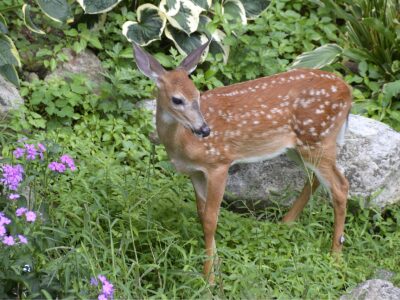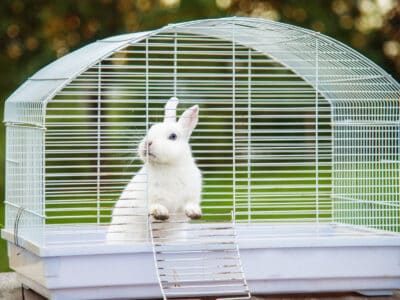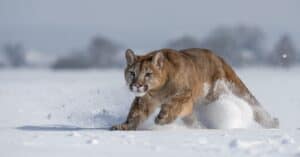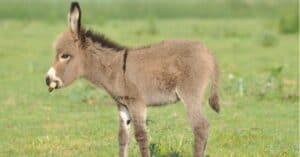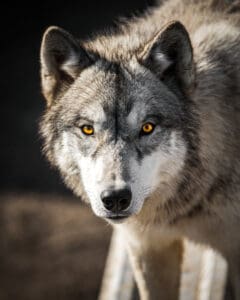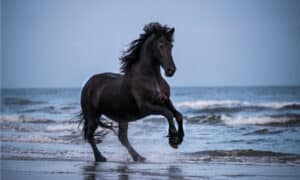Buffalo vs Wildebeest: What Are the 5 Major Differences?
Africa is home to many large mammals, including elephants and rhinos. The vast continent also contains some very interesting members of the bovine family. While most people are familiar with domesticated cattle or bison, Africa has buffaloes and wildebeests. Today, we’re going to show you how these creatures are different from one another. We’ll perform a buffalo vs wildebeest comparison to show you what makes them distinct and where you can find them.
For the sake of comparison, we’re going to use data from the African buffalo because this species shares a range with the wildebeest and offers the greatest differences.
Comparing a Buffalo and a Wildebeest

A-Z-Animals.com
| Buffalo | Wildebeest | |
|---|---|---|
| Size | Weight: 1,300 lbs – 2,000 lbs Height: 3.5 ft-5.6 ft tall at the shoulder Length: 5 ft-11 ft |
Weight: 265 lbs – 600 lbs Height: 4.3ft – 4.8 ft Length: 5ft-8ft |
| Morphology | – Quadrupedal ungulate with large head and body – Brown or black, but some may be reddish – Has long horns that grow horizontally from the head and then curve up and back toward the head – Head is carried low relative to the shoulders – The horns are connected by a bone shield in the middle called a boss |
– Quadrupedal ungulate with a large head – Dark gray or brown, and it may have stripes or even a bluish color – Often has a shaggy mane around the sides and underside of the face – Horns that develop horizontally and then curve downwards and back toward the head at the tips – Head is carried above the shoulders |
| Behavior | – Partially migratory – Unpredictable and dangerous to humans – Not domesticated – Grazing animal that resides in a herd – Powerful creatures that can fight off some predators |
– Migratory creature, though some are nomadic – Not domesticated – Live in a herd |
| Species | – Syncerus caffer – Several subspecies exist, including the cape, forest, Sudan, and the Nile |
– Connochaetes Taurinus – Also called a gnu – A few subspecies exist, including black and blue |
| Location | – African buffalo live in large swaths of sub-Saharan Africa, especially around the savannahs, woodlands, and sometimes near rainforests – Lives in Kenya, Botswana, Tanzania, and the Democratic Republic of Congo – Other buffalo species live in Asia, such as the water buffalo |
– The most southern third of Africa, along with some spots on the central-east coast of the continent – Found in Angola, South Africa, Zambia, Tanzania, and others – Lives in Savannahs, plains, and other grasslands |
The 5 Key Differences Between a Buffalo vs Wildebeest

Kristof Bellens/Shutterstock.com
The greatest differences between a buffalo and a wildebeest include their morphology, behavior, and location. Buffaloes are large, partially migratory ungulates with a brown, black, or reddish color and large horns that form a boss on the animals’ heads from most of sub-Saharan Africa. Wildebeests are smaller ungulates with gray or brown hair and stripes in some cases with a shaggy mane and a head carried above the shoulders that live in migratory herds in the southern third of Africa.
These animals look similar since they are large members of the bovine family. However, we can use the available data to distinguish between them in multiple ways. Let’s examine each creature and compare them to one another to fully understand their unique qualities.
Buffalo vs Wildebeest: Size
Buffaloes are much larger than wildebeests. The largest buffalo can weigh upwards of 2,000 lbs, stand 5.6 ft tall at the shoulder, and measure 11 ft long. That is far bigger than a wildebeest that can only weigh about 550 or 600 lbs, grows 4.8 ft tall, and measures perhaps 8 ft long.
The buffalo is a very large, powerful creature, making the wildebeest seem small in comparison.
Buffalo vs Wildebeest: Morphology
The greatest differences between buffaloes and wildebeests are morphological. A buffalo is a large quadruped that is often brown, black, or reddish-brown. It has a long snout, rather short fur, and large horns. At least Cape Buffalo, the largest of the species, has large horns.
In particular, their horns grow to the side of the head and then curve upwards and eventually point back toward the head. The two horns connect on the front of the buffalo’s head in a bony shield called a boss. These animals also carry their heads below their shoulders in a lot of cases.
The wildebeest has a large head with a shaggy mane on the sides and underside. It can be brown or dark gray, and it sometimes appears almost blue. Wildebeests can have stripes on their sides as well. Their horns are smaller than Cape buffalo’s horns, and they develop horizontally, curve downwards, and then curve upwards towards the head.
The black wildebeest has horns that grow slightly forward from their heads but still take on a curving shape. These mammals also carry their heads above their shoulders, so they can appear quite tall.
Buffalo vs Wildebeest: Behavior
Wildebeests are migratory creatures for the most part, but some of them are merely nomadic and seek food and water where it’s available. These animals are not domesticated and live in large herds that can vary in size. They spend a lot of their time grazing.
Buffaloes are partially migratory, but they tend to stay in the same area. These creatures are not domesticated like other bovines because they are too wild and unpredictable to humans. They also live in a herd of varying sizes. Buffaloes are known for being strong animals, capable of warding off threats from large predators like lions and wild dogs. However, they are not always successful.
Buffalo vs Wildebeest: Species
Although buffaloes and wildebeests seem like they’re from the same species, they’re not. Both of them belong to the Bovidae family, but they differ from there. For example, true buffalo, not bison, belong to Syncerus caffer, and they have several subspecies.
Wildebeests are members of the Connochaetes taurinus species, also known as gnu. They have two subspecies, the black wildebeest and the blue wildebeest.
Buffalo vs Wildebeest: Location
Buffalo and wildebeest both live in Africa. However, buffalo are more widespread than wildebeests throughout Africa and the world at large. Buffaloes live in Kenya, Botswana, Tanzania, the Democratic Republic of Congo, and other countries. Other species of buffalo, like water buffalo, live in Asia. They prefer to live in savannahs, woodlands, and near rainforests.
Wildebeests live in the southern third of Africa and some coastal areas. The countries include Angola, South Africa, Tanzania, Zambia, and others. They also prefer savannahs and grasslands, but they do not frequent rainforest areas.
The two animals do overlap in their distribution to some extent, but the buffalo are found in a wider area.
Buffalo vs Wildebeest: Who Would Win in a Fight?
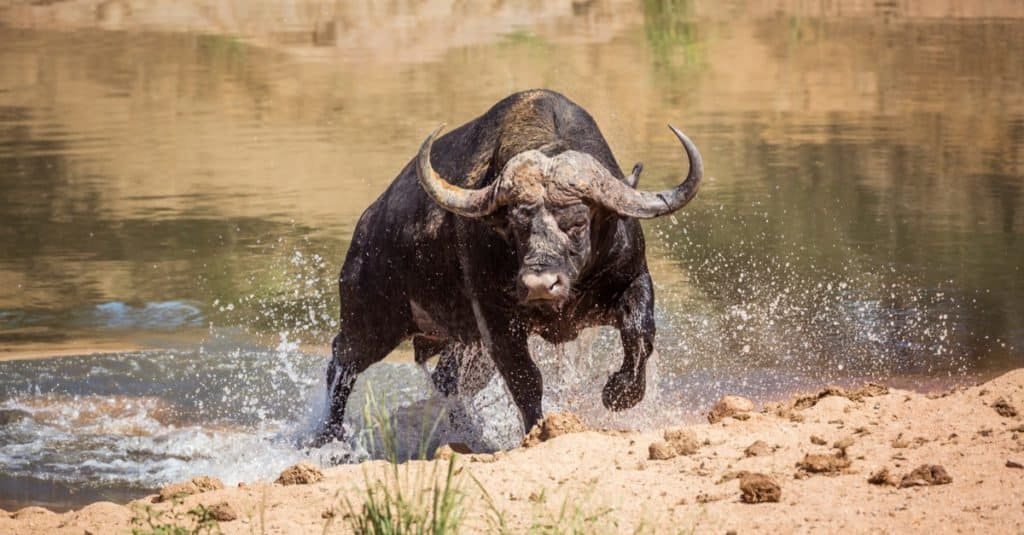
PACO COMO/Shutterstock.com
A buffalo would win a fight against a wildebeest. For the most part, buffaloes are far too large for a wildebeest to attempt to kill. The buffalo would charge the wildebeest and knock it over with its immense power and weight focused on the boss on its head.
From there, the mammal would be free to trample the wildebeest or try to gore it with its massive horns. It’s hard to imagine this fight going any other way, and the wildebeest would certainly have few avenues that lead to success.
Of course, these two animals are herbivorous and not likely to fight each other at all. Moreover, they are both herd animals, so neither creature would ever fight alone. If they did, though, the buffalo would handily win the battle and send the wildebeest fleeing or to an early grave.
More from A-Z Animals
Africa is home to many large mammals, including elephants and rhinos. The vast continent also contains some very interesting members of the bovine family. While most people are familiar with domesticated cattle or bison, Africa has buffaloes and wildebeests. Today, we’re going to show you how these creatures are different from one another. We’ll perform a buffalo vs wildebeest comparison to show you what makes them distinct and where you can find them.
For the sake of comparison, we’re going to use data from the African buffalo because this species shares a range with the wildebeest and offers the greatest differences.
Comparing a Buffalo and a Wildebeest

A-Z-Animals.com
| Buffalo | Wildebeest | |
|---|---|---|
| Size | Weight: 1,300 lbs – 2,000 lbs Height: 3.5 ft-5.6 ft tall at the shoulder Length: 5 ft-11 ft |
Weight: 265 lbs – 600 lbs Height: 4.3ft – 4.8 ft Length: 5ft-8ft |
| Morphology | – Quadrupedal ungulate with large head and body – Brown or black, but some may be reddish – Has long horns that grow horizontally from the head and then curve up and back toward the head – Head is carried low relative to the shoulders – The horns are connected by a bone shield in the middle called a boss |
– Quadrupedal ungulate with a large head – Dark gray or brown, and it may have stripes or even a bluish color – Often has a shaggy mane around the sides and underside of the face – Horns that develop horizontally and then curve downwards and back toward the head at the tips – Head is carried above the shoulders |
| Behavior | – Partially migratory – Unpredictable and dangerous to humans – Not domesticated – Grazing animal that resides in a herd – Powerful creatures that can fight off some predators |
– Migratory creature, though some are nomadic – Not domesticated – Live in a herd |
| Species | – Syncerus caffer – Several subspecies exist, including the cape, forest, Sudan, and the Nile |
– Connochaetes Taurinus – Also called a gnu – A few subspecies exist, including black and blue |
| Location | – African buffalo live in large swaths of sub-Saharan Africa, especially around the savannahs, woodlands, and sometimes near rainforests – Lives in Kenya, Botswana, Tanzania, and the Democratic Republic of Congo – Other buffalo species live in Asia, such as the water buffalo |
– The most southern third of Africa, along with some spots on the central-east coast of the continent – Found in Angola, South Africa, Zambia, Tanzania, and others – Lives in Savannahs, plains, and other grasslands |
The 5 Key Differences Between a Buffalo vs Wildebeest

Kristof Bellens/Shutterstock.com
The greatest differences between a buffalo and a wildebeest include their morphology, behavior, and location. Buffaloes are large, partially migratory ungulates with a brown, black, or reddish color and large horns that form a boss on the animals’ heads from most of sub-Saharan Africa. Wildebeests are smaller ungulates with gray or brown hair and stripes in some cases with a shaggy mane and a head carried above the shoulders that live in migratory herds in the southern third of Africa.
These animals look similar since they are large members of the bovine family. However, we can use the available data to distinguish between them in multiple ways. Let’s examine each creature and compare them to one another to fully understand their unique qualities.
Buffalo vs Wildebeest: Size
Buffaloes are much larger than wildebeests. The largest buffalo can weigh upwards of 2,000 lbs, stand 5.6 ft tall at the shoulder, and measure 11 ft long. That is far bigger than a wildebeest that can only weigh about 550 or 600 lbs, grows 4.8 ft tall, and measures perhaps 8 ft long.
The buffalo is a very large, powerful creature, making the wildebeest seem small in comparison.
Buffalo vs Wildebeest: Morphology
The greatest differences between buffaloes and wildebeests are morphological. A buffalo is a large quadruped that is often brown, black, or reddish-brown. It has a long snout, rather short fur, and large horns. At least Cape Buffalo, the largest of the species, has large horns.
In particular, their horns grow to the side of the head and then curve upwards and eventually point back toward the head. The two horns connect on the front of the buffalo’s head in a bony shield called a boss. These animals also carry their heads below their shoulders in a lot of cases.
The wildebeest has a large head with a shaggy mane on the sides and underside. It can be brown or dark gray, and it sometimes appears almost blue. Wildebeests can have stripes on their sides as well. Their horns are smaller than Cape buffalo’s horns, and they develop horizontally, curve downwards, and then curve upwards towards the head.
The black wildebeest has horns that grow slightly forward from their heads but still take on a curving shape. These mammals also carry their heads above their shoulders, so they can appear quite tall.
Buffalo vs Wildebeest: Behavior
Wildebeests are migratory creatures for the most part, but some of them are merely nomadic and seek food and water where it’s available. These animals are not domesticated and live in large herds that can vary in size. They spend a lot of their time grazing.
Buffaloes are partially migratory, but they tend to stay in the same area. These creatures are not domesticated like other bovines because they are too wild and unpredictable to humans. They also live in a herd of varying sizes. Buffaloes are known for being strong animals, capable of warding off threats from large predators like lions and wild dogs. However, they are not always successful.
Buffalo vs Wildebeest: Species
Although buffaloes and wildebeests seem like they’re from the same species, they’re not. Both of them belong to the Bovidae family, but they differ from there. For example, true buffalo, not bison, belong to Syncerus caffer, and they have several subspecies.
Wildebeests are members of the Connochaetes taurinus species, also known as gnu. They have two subspecies, the black wildebeest and the blue wildebeest.
Buffalo vs Wildebeest: Location
Buffalo and wildebeest both live in Africa. However, buffalo are more widespread than wildebeests throughout Africa and the world at large. Buffaloes live in Kenya, Botswana, Tanzania, the Democratic Republic of Congo, and other countries. Other species of buffalo, like water buffalo, live in Asia. They prefer to live in savannahs, woodlands, and near rainforests.
Wildebeests live in the southern third of Africa and some coastal areas. The countries include Angola, South Africa, Tanzania, Zambia, and others. They also prefer savannahs and grasslands, but they do not frequent rainforest areas.
The two animals do overlap in their distribution to some extent, but the buffalo are found in a wider area.
Buffalo vs Wildebeest: Who Would Win in a Fight?

PACO COMO/Shutterstock.com
A buffalo would win a fight against a wildebeest. For the most part, buffaloes are far too large for a wildebeest to attempt to kill. The buffalo would charge the wildebeest and knock it over with its immense power and weight focused on the boss on its head.
From there, the mammal would be free to trample the wildebeest or try to gore it with its massive horns. It’s hard to imagine this fight going any other way, and the wildebeest would certainly have few avenues that lead to success.
Of course, these two animals are herbivorous and not likely to fight each other at all. Moreover, they are both herd animals, so neither creature would ever fight alone. If they did, though, the buffalo would handily win the battle and send the wildebeest fleeing or to an early grave.


